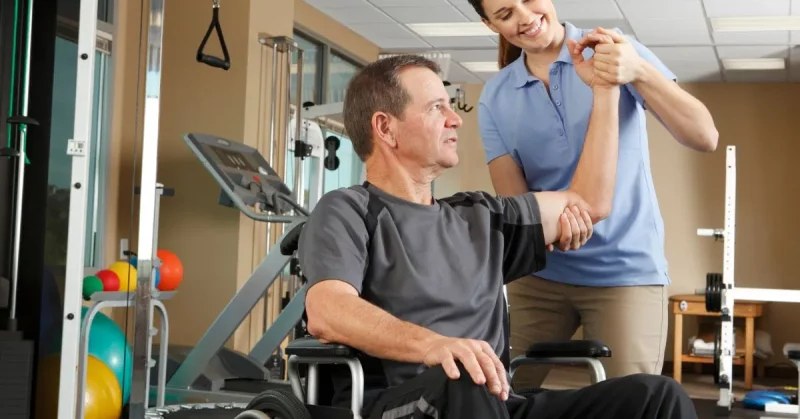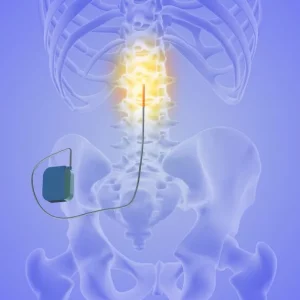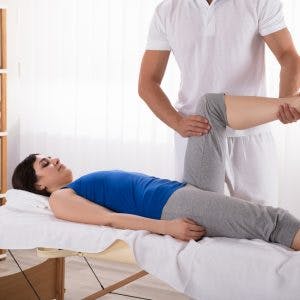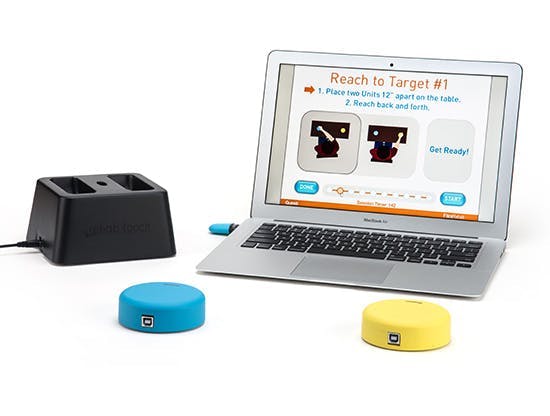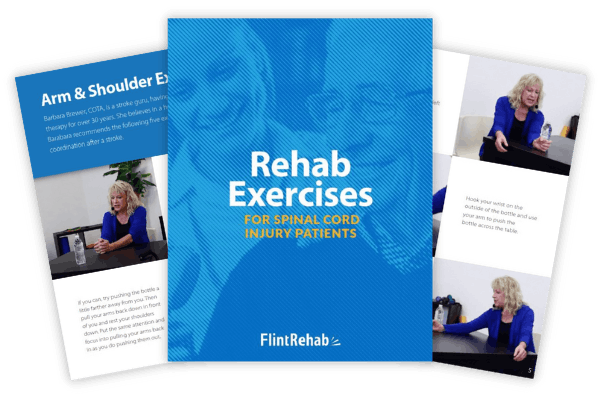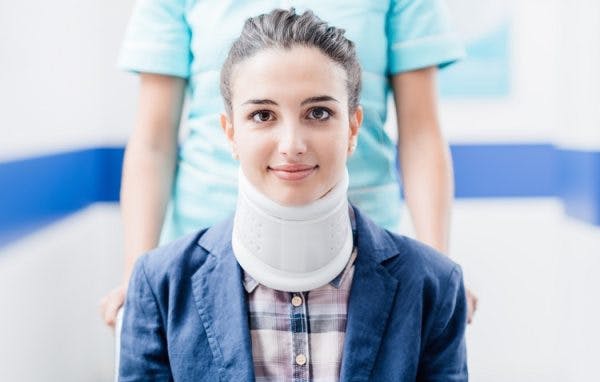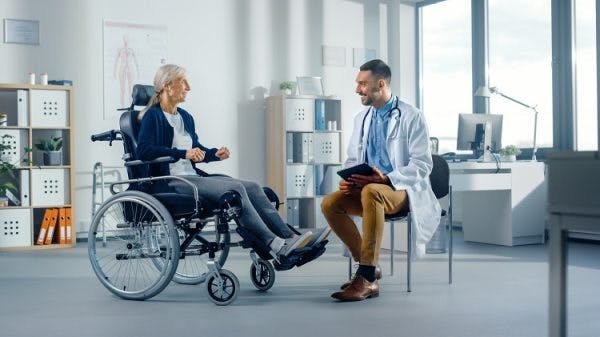Spinal cord injuries (SCI) can change nearly every part of daily life, from movement and sensation to bladder control and mental health. But while the journey after SCI can feel overwhelming, rehabilitation offers a path toward regaining independence and improving quality of life.
This guide will walk you through what spinal cord injury rehabilitation involves, how it works, the tools that can help, and tips to stay motivated along the way.
Jump to a section:
What is spinal cord injury rehabilitation?
How Rehab After Spinal Cord Injury Supports Neuroplasticity
Acute vs. Long-Term Rehabilitation for Spinal Cord Injury
Types of Therapies in SCI Rehabilitation
Tools That Support Spinal Cord Injury Rehabilitation and Recovery
Home Modifications for Accessibility After Spinal Cord Injury
Life Skills Training and Vocational Rehabilitation After Spinal Cord Injury
Nutrition After Spinal Cord Injury
Common Complications After SCI and How to Manage Them
Staying Motivated During the Recovery Process After Spinal Cord Injury
What Is Spinal Cord Injury Rehabilitation?
Spinal cord injury rehabilitation refers to a wide range of treatments and therapies designed to help individuals recover as much function as possible after an SCI. Recovery doesn’t always mean a full return to pre-injury abilities, but rehab focuses on maximizing physical, emotional, and social function.
Rehab typically includes:
- Physical therapy to improve strength and mobility
- Occupational therapy to support daily living skills
- Speech therapy (if needed) for improving respiratory complications, speech difficulties, and dysphagia
- Psychosocial support
- Adaptive technology training
- Education about SCI and self-care
The goal of rehabilitation after a spinal cord injury is to help each person live as independently and confidently as possible.
How Rehab After Spinal Cord Injury Supports Neuroplasticity
One of the most important concepts in SCI rehab is neuroplasticity, which is the nervous system’s ability to adapt and reorganize itself. Even after damage to the spinal cord, the brain and spinal cord have the potential to create new connections with repeated, consistent activity.
Neuroplasticity means that function may be improved even in areas that were affected by the injury, especially through targeted therapy. While the amount of recovery can vary, engaging in regular rehab exercises is essential to encourage this process.
It is important to note that individuals who have had a complete spinal cord injury, where the spinal cord has been fully severed with no remaining neural pathways left intact, may not be able to regain lost functions below the level of injury through traditional rehabilitative techniques. However, new treatments such as stem cell therapy are showing great promise for promoting improvements, even among complete SCI survivors.
By activating neuroplasticity, those who have sustained an incomplete spinal cord injury often have a higher likelihood of regaining lost functions, even below their level of injury.
Acute vs. Long-Term Rehabilitation for Spinal Cord Injury
Rehabilitation for spinal cord injury often begins in the hospital shortly after the injury before it transitions into long-term care. While each stage of spinal cord injury rehab is important, they each have their own purpose and focus.
Let’s take a look at some of the focuses for each stage of SCI recovery.
Acute Rehabilitation
This happens during the initial hospital stay. The medical team focuses on:
- Stabilizing the spine
- Managing complications (like blood pressure or breathing)
- Beginning basic movement training (such as bed mobility)
- Preventing joint stiffness and muscle atrophy
In the acute rehabilitation phase of spinal cord injury, physical and occupational therapists may start working with the patient right away, even while they’re still in bed.
Subacute and Long-Term Rehabilitation
Once medically stable, the next stage involves more structured rehab. This may take place in an inpatient rehab center, outpatient clinic, or at home.
In this phase, therapy becomes more intensive and focuses on:
- Building strength and coordination
- Relearning everyday activities like dressing and transferring
- Adapting to mobility aids (wheelchairs, walkers, braces)
- Improving bowel and bladder management
- Learning new ways to navigate work, home, or community life
Progress in the subacute and long term rehabilitation stage varies widely depending on the level and severity of the injury, but regular participation in rehab can make a significant difference over time.
Types of Therapies in SCI Rehabilitation
There are many different types of rehab and therapy for spinal cord injury rehabilitation. These can include physical therapy, occupational therapy, speech therapy, as well as emotional and psychological support.
Let’s take a look at each a little more in depth.
Physical Therapy
The goal of physical therapy during spinal cord injury rehab is to help improve strength, coordination, and movement in the parts of the body affected by the injury. This can include techniques focused on:
- Stretching and range of motion exercises
- Strengthening exercises for muscles that are still active
- Functional electrical stimulation (FES) to activate paralyzed muscles
- Gait training (walking) for those with incomplete injuries
- Wheelchair mobility training
In addition, therapists also teach safe body mechanics to help prevent injury and pain.
Occupational Therapy
Next, occupational therapy focuses on improving and recovering the skills needed for daily living after spinal cord injury. Some examples of these skills may include:
- Feeding, dressing, grooming, and bathing
- Transferring in and out of a wheelchair or bed
- Using adaptive tools for cooking or writing
- Home modifications to improve access and safety
- Training with assistive devices
The goal of occupational therapy is to help people regain independence in the areas that matter most to them, including self-care, functional mobility, and returning to work if appropriate.
Speech and Cognitive Therapy
Some spinal cord injuries, especially those involving the higher cervical spine or with co-occurring brain trauma, can affect speech or cognition. In these cases, therapy may address:
- Voice and speech clarity
- Respiratory complications affecting speech production
- Swallowing safely
- Memory, attention, and problem-solving skills
- Communication aids or strategies
Emotional and Psychological Support
Finally, the emotional and psychological aspect of recovery after spinal cord injury is often looked at as a secondary piece of recovery. However, the mental and emotional side of SCI recovery is just as important as the physical.
Depression, anxiety, grief, and frustration are common, especially in the early stages of recovery. Working with a psychologist or counselor can help individuals and families cope with these feelings and adjust to the “new normal.”
Support groups, whether in person or online, are also valuable for reducing isolation and sharing advice with others who truly understand the challenges of SCI.
3 Tools That Support Spinal Cord Injury Rehabilitation and Recovery
Rehab doesn’t stop when the therapy session ends. Many tools can support recovery at home and encourage consistent practice, which is essential for long-term progress.
FitMi for Whole-Body Rehab
FitMi is an interactive rehabilitation device designed to help users improve mobility through high-repetition, gamified exercises. It targets both upper and lower body and adapts to the user’s ability level.
Why it helps:
- Encourages more reps than traditional therapy
- Makes exercise more engaging
- Tracks progress to stay motivated
FitMi is often used by individuals with SCI to supplement outpatient therapy or continue progress at home.
Standing Frames and Body Weight Support Systems
Standing frames and body weight support systems allow individuals with paralysis to stand upright and even work on walking using support. Benefits include:
- Improving circulation
- Maintaining bone density
- Supporting bowel and bladder function
- Preventing pressure sores
Standing regularly can also help with mood and provide a sense of normalcy.
Functional Electrical Stimulation (FES)
FES uses low-level electrical currents to stimulate nerves and activate paralyzed muscles. It can be used during:
- Cycling or walking exercises
- Arm or leg strengthening
- Hand function training
Research suggests FES may help maintain muscle mass and support neuroplasticity in people with incomplete injuries.
Life Skills Training and Vocational Rehabilitation After Spinal Cord Injury
Recovery is not just physical but it’s also about rebuilding a meaningful life. Many rehab programs include life skills training, which covers:
- Managing medications and appointments
- Using public transportation or driving with adaptive equipment
- Planning meals and managing finances
Vocational rehabilitation services can also help individuals return to work or school. This may include:
- Job retraining
- Workplace modifications
- Resume building and interview prep
Be sure to ask your rehab specialist or doctor for resources. With the right support, many people with SCI find new career paths or return to roles they enjoyed before the injury.
Home Modifications for Accessibility After Spinal Cord Injury
Creating a safe, accessible living environment is one of the most important steps you can take after a spinal cord injury (SCI). A well-adapted home not only helps you maintain independence but also reduces the risk of falls, injuries, and unnecessary strain.
Occupational therapists can help assess your home and provide suggestions for how to best modify the existing environment for make it more accessible and promote independence. Some of these changes may include things like:
- Installing ramps or stair lifts
- Widening doorways
- Adding grab bars and roll-in showers
- Lowering countertops and light switches
- Rearranging furniture and decluttering to allow for wide, clear paths
Making these adjustments early in your recovery can help you avoid preventable injuries, reduce daily frustration, and maintain greater control over your routines. They also give you the confidence to move through your home freely without relying on constant assistance.
If you’re unsure where to begin, talk with your care team about requesting a home safety evaluation.
Nutrition After Spinal Cord Injury
Nutrition plays a critical role in recovery and overall health after a spinal cord injury. The body often undergoes significant changes in energy needs, muscle mass, and metabolism. Additionally, SCI can affect bowel and bladder function, making proper nutrition even more important for maintaining comfort, preventing complications, and supporting long-term health.
While different individuals may require specific nutrition plans,. some general advice for managing nutrition after spinal cord injury includes:
- Focus on fiber-rich foods to support bowel health
- Stay hydrated to prevent UTIs and constipation
- Maintain a balanced diet to manage weight and reduce pressure sore risk
- Consult a dietitian if you have specific concerns
Some people also benefit from supplements, especially if bone density is an issue. Discuss with your doctor or in some cases a nutritionist may be covered by your health insurance plan.
Common Complications After SCI and How to Manage Them
Rehabilitation also involves learning how to manage common secondary conditions associated with SCI:
Pressure Sores
- Change positions frequently (at least every 2 hours)
- Use pressure-relieving cushions and mattresses
- Inspect skin daily
Spasticity
- Regular stretching
- Medications (as prescribed)
- Botulinum toxin injections (if needed)
Autonomic Dysreflexia
- Know the symptoms (sudden headache, flushing, high blood pressure)
- Learn to identify and remove the cause (e.g., full bladder, tight clothing)
- Seek emergency care if symptoms persist
Rehab professionals can teach self-management strategies for these issues and others that may arise.
Staying Motivated During the Recovery Process After Spinal Cord Injury
Recovery from SCI is often a long-term journey. Progress can be slow, and plateaus are common. But persistence pays off.
Here are a few ways to stay on track:
- Set short-term, realistic goals
- Celebrate small victories
- Use gamified tools to make therapy more engaging
- Stay connected to others through support groups or online communities
- Track your progress to see how far you’ve come
It’s normal to feel frustrated at times, but each step forward matters.
Final Thoughts
Spinal cord injury rehabilitation is about more than just physical recovery. It’s about learning new ways to live, move, and connect with others. With the right combination of therapies, tools, and support, many people with SCI lead fulfilling, independent lives.
Whether you’re early in your recovery or years post-injury, continuing rehabilitation can make a difference. The path may not be easy, but with consistent effort and the right resources, progress is possible.
